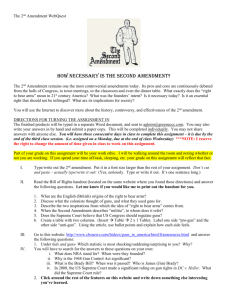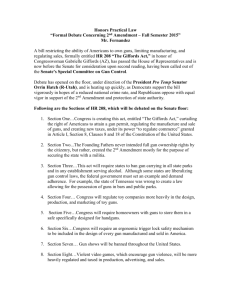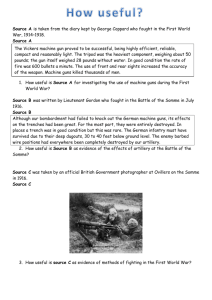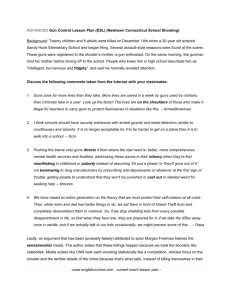The Right to Keep and Bear Arms in America: Stronger than Ever
advertisement
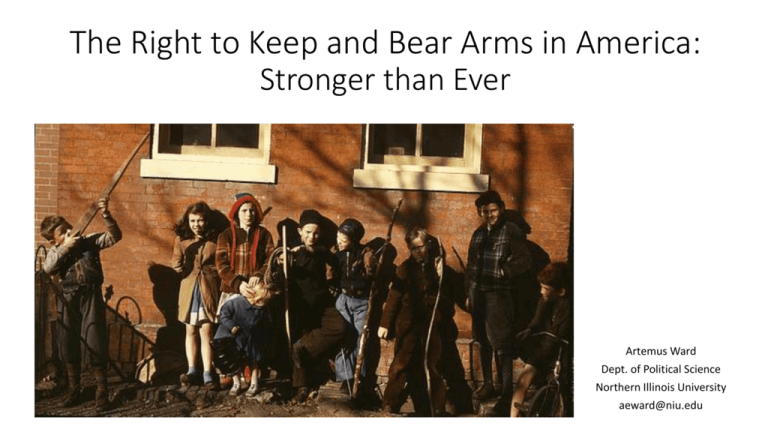
The Right to Keep and Bear Arms in America: Stronger than Ever Artemus Ward Dept. of Political Science Northern Illinois University aeward@niu.edu • Gun rights have never been stronger, and guns more prevalent, in America than they are right now. • Gun rights advocates have the most powerful lobby in Washington, D.C. and have been wildly successful in promoting gun rights, thwarting gun regulation, cutting off federal funding for research, and stymieing data collection and sharing. • Both major political parties favor gun rights. • The U.S. Supreme Court recently articulated and individual right to own a gun that neither the federal government nor any state can infringe. • In short, the gun rights movement has been a resounding success and is instructive for how legal, political, and social change happens in America. Introduction The nd 2 Amendment • What does this mean? Competing Interpretations • There are generally two distinct positions on what the 2nd Amendment means: 1. Pro-gun interests emphasize the second half of the amendment and conclude that it guarantees a constitutional individual right to keep and bear arms. 2. Those who favor government restrictions on private gun ownership emphasize the first half of the amendment. They argue that it protects only a collective right or the states to arm their militias; there is no individual right, unless it is in conjunction with a state militia, to own firearms. • Which one is correct? Public Opinion • Between 35%45% of Americans own a gun totaling roughly 1/3 of the 1 billion guns owned worldwide. • A 2008 Gallup Poll showed that 3 out of 4 Americans believe they have the right to own guns. Public Opinion • Not surprisingly, gun owners are more supportive of an individual right than are those who do not own guns. • Perhaps surprisingly, those who do not own guns still overwhelmingly support the individual-right position. Public Opinion Public Opinion • Yet at the same time, half of Americans favor more restrictive gun laws. • Why? United States v. Miller (1939) • Until recently, over its 200-year history, the Supreme Court had only decided 6 cases dealing directly with the 2nd Amendment. • In the most important of these, United States v. Miller (1939), the Court unanimously upheld the National Firearms Act (1934) which regulated “gangster weapons” including machine guns, sawed-off shotguns, and silencers, essentially requiring them to register with the federal government. • Justice James McReynolds wrote for the Court adopting the collectiveright point-of-view. The opinion reasoned that because there was no evidence to show that these particular weapons had any relationship to the preservation or efficiency of a well regulated militia, they were not protected by the 2nd Amendment. • The justices also reasoned that because Article 1, Sec. 8 of the Constitution gives congress the power to call forth and arm the militia, but reserves to the states the power to appoint officers and train them, the 2nd Amendment was to aid in this process. Miller’s Aftermath: Gun Control Act of 1968 • The effect of Miller was that the militia, collective-right view generally won out in America and federal gun control laws (such as requiring registration and banning handguns and automatic weapons) were passed and never struck down under 2nd amendment grounds. • Because the Court did not recognize an individual right to keep and bear arms, state and local governments were free to regulate guns as they saw fit. • In the wake of the assassinations of the Kennedys and Martin Luther King and the armed and violent protests that followed, congress passed at President Lyndon Johnson signed into law the Gun Control Act of 1968—the first major gun control law in decades. • The law banned mail order sales of rifles and shotguns and prohibited most felons, drug users, and people found mentally incompetent from buying guns. 1968 Republican Party Platform • The same year, the Republican Party took a moderate position on guns as part of their presidential nominee Richard Nixon’s emphasis on law and order. • Their platform favored “enactment of legislation to control indiscriminate availability of firearms” while “safeguarding the right of responsible citizens to collect, own and use firearms for legitimate purposes,” and recommended a balance between federal and state responsibilities. National Rifle Association (NRA) • In 1977 the NRA began transforming from an organization for hunters and sportsmen that promoted gun safety and was not particularly political to the politically powerful gun rights organization we know today. • For example, they had supported all of the federal regulations of the 1930s and parts of the 1968 Gun Control Act including restrictions for felons and the mentally disabled. Brady Bill (1993) • The 1981 assassination attempt of Ronald Reagan and shooting of his press secretary James Brady ultimately led to, after sustained opposition by the NRA, the passage of a new gun control law. • The Brady Handgun Violence Prevention Act of 1993 enhanced the Gun Control Act of 1968 by creating a background check system which required licensed sellers to inspect the criminal history background of prospective gun purchasers. Initially, it called for a 5-day waiting period, but the NRA successfully lobbied to change it to instantaneous with the sale. • It also added to the list of categories of individuals to whom the sale of firearms is prohibited including felons, fugitives, drug users, the mentally disabled, illegal aliens, dishonorably discharged former military personnel, those who have renounced their citizenship, those under restraining orders, those convicted of misdemeanor domestic violence. The Rise of the NRA • Wayne LaPierre led the organization’s efforts to mobilize the American people, undo gun control legislation, and ensure that legislators supported gun rights. • They undertook a massive publicity campaign to make gun rights synonymous with being patriotic. To be pro gun was to be an American. • They hired actor Charlton Heston to be their spokesperson. They raised enormous sums of money, lobbied politicians, and contributed money to political campaigns. • For example, they spent $20 million on the 2000 election to defeat Democratic presidential nominee Al Gore—a gun regulation advocate. In many of the states that Gore lost like Florida, West Virginia, and his home state of Tennessee, the NRA’s anti-Gore campaign made the difference. Had Gore won any of these states, he would have won the presidency. District of Columbia v. Heller (2008) • In 1976 the District of Columbia, concerned with the high levels of gun-related crime, passed the nation’s most restrictive gun control ordinance. The law essentially banned the private possession of handguns. Shotguns and rifles could be owned, but only if the weapons were registered, kept unloaded, and disassembled or restricted by trigger locks. The law allowed the chief of police, under certain circumstances, to issue a one-year certificate to carry a handgun. • Dick Heller, a D.C. police officer, had been granted a license to carry a handgun while on duty providing security at the Federal Judicial Center. Heller applied for permission to own a handgun for self-defense, but he was refused. Claiming that the District’s statute violated his Second Amendment right to bear arms, Heller brought a suit against the city. Robert A. Levy and the Creation of a Test Case • Heller’s case was orchestrated by Florida attorney Robert Levy who had become a wealthy man in his first career as a money manager. At 49, he entered George Mason Law School and graduated first in his class. After clerking for two federal judges, he devoted his professional life to libertarian causes. • Levy, who had never owned a gun, saw DC’s law as a violation of personal freedom and private property rights. He recruited 6 possible plaintiffs to challenge the law, but only Heller met the strict standing requirements to pursue legal action. • To eliminate any possible influence over the case by the National Rifle Association (NRA) and any other gun rights group, Levy funded the litigation out of his own pocket. The NRA objected to the timing of the lawsuit and the George W. Bush administration was also suspicious. • Alan Gura, whom Levy chose to argue the case before the Supreme Court, later said that he was frustrated with the Bush Justice Department under John Ashcroft, who was attorney general when the case first arose, for not pressing the Supreme Court hard enough. “Clearly there are government lawyers who are very jealous of their authority and they don’t need any more constitutional rights out there restricting their freedom of operation,” Gura said. • Ultimately, Levy went on to become Chairman of the libertarian Cato Institute. March 18, 2008. Solicitor General Paul Clement makes his argument without any notes in front of (L-R): Justices Breyer, Kennedy, Stevens, Chief Justice Roberts, Scalia, Souter, and Ginsburg. Sitting next to Ginsburg, but not pictured here, were Justices Thomas and Alito. District of Columbia v. Heller (2008) An Individual Right • Justice Antonin Scalia delivered the 5-4 majority opinion, striking down the DC law and declaring a right to own handguns for self-defense in the home. • The Court engaged in both a textual and historical analysis of the 2nd Amendment. • Scalia explained: • the “right of the people” means an individual right as it is used elsewhere in the Constitution; • “arms” applies “to weapons that were not specifically designed for military use and were not employed in a military capacity” hence, non-military weapons are protected; • “to keep arms” means “to retain… to have in custody… to hold; to retain in one’s power or possession” • “bear” means to “carry” for a purpose – confrontation. • Scalia concluded that in an era when there was no standing U.S. Army, everyone understood the right to keep and bear arms as an individual one in case a militia was necessary to fight oppressors if order broke down. • “Putting all of these textual elements together, we find that they guarantee the individual right to possess and carry weapons in case of confrontation. This meaning is strongly confirmed by the historical background of the Second Amendment.” District of Columbia v. Heller (2008) The Right to Self-Defense • The justices further reasoned that the inherent right of self-defense is central to having a gun in the home for protection. • “[T]he inherent right of self-defense has been central to the Second Amendment right. The handgun ban amounts to a prohibition of an entire class of ‘arms’ that is overwhelmingly chosen by American society for that lawful purpose. The prohibition extends, moreover, to the home, where the need for defense of self, family, and property is most acute. Under any of the standards of scrutiny that we have applied to enumerated constitutional rights, banning from the home ‘the most preferred firearm in the nation to “keep” and use for protection of one’s home and family,’ would fail constitutional muster.” • Scalia has said that he considers the opinion the greatest vindication of his originalist approach to constitutional interpretation. District of Columbia v. Heller (2008) • Justice John Paul Stevens, joined by Justices David Souter, Ruth Bader Ginsburg, and Stephen Breyer dissented. • He explained that the 2nd Amendment was passed as a response to fears that Congress would disarm state militias and create a national standing army. Stevens said that it has nothing to do with regulating private civilian use of firearms and does not enshrine the common-law right of selfdefense in the Constitution. • Hence, the right to keep and bear arms is for military purposes. Congress may regulate civilian use. • “Even if the textual and historical arguments on both sides of the issue were evenly balanced, respect for the well-settled views of all of our predecessors on this Court, and for the rule of law itself would prevent most jurists from endorsing such a dramatic upheaval in the law. . . .” • “Until today, it has been understood that legislatures may regulate the civilian use and misuse of firearms so long as they do not interfere with the preservation of a well-regulated militia. The Court’s announcement of a new constitutional right to own and use firearms for private purposes upsets that settled understanding.” Stevens had been so confident of his ability to win a majority and that his argument would carry the day that he circulated his draft dissent before Scalia circulated his draft majority opinion. McDonald v. Chicago (2010) • In McDonald v. Chicago (2010) the Court ruled 5-3 that the 2nd Amendment right to keep and bear arms for self-defense applies to state and local governments as well as the federal government. Hence Chicago’s local gun ban was unconstitutional. • Writing for four justices, Justice Samuel Alito held that the 2nd Amendment was incorporated via the 14th Amendment’s Due Process Clause. • In a separate concurrence, Justice Clarence Thomas said that he would overturn The Slaughter-House Cases (1873) and incorporate the 2nd Amendment via the 14th Amendment’s Privileges and Immunities Clause. Contemporary Developments • Despite the mass shootings in recent years (even of 6 and 7 year old children at Sandy Hook elementary school), no gun control legislation was passed. • Banning assault weapons or high-capacity magazines was off the table. Even toughening background check laws or regulating gun shows did not happen— even though 90% of the American people favor expanded background checks. • Indeed, the NRA’s position has been that the solution to gun violence is more guns. The legislation that has been passed has been to allow individuals to carry concealed guns. Calls to arm teachers and other officials have been made and grow louder with each school shooting. Enforcing Existing Gun Laws • Weak laws and loopholes backed by the gun lobby make it easier to get guns illegally. • Around 40% of all legal gun sales involve private sellers and don't require background checks. 40% of prison inmates who used guns in their crimes got them this way. • An investigation found 62% of online gun sellers were willing to sell to buyers who said they couldn't pass a background check. • 20% of licensed California gun dealers agreed to sell handguns to researchers posing as illegal "straw" buyers. • The Bureau of Alcohol, Tobacco, Firearms, and Explosives did not have a permanent director for 7 years, due to an NRA-backed requirement that the Senate approve nominees. Are They Coming for your Guns? • No one knows the exact number of guns in America, but it's clear there's no practical way to round them all up (never mind that no one in Washington is proposing this). Yet if you fantasize about rifle-toting citizens facing down the government, you'll rest easy knowing that America's roughly 80 million gun owners already have the feds and cops outgunned by a factor of around 79 to 1. • Source: Congressional Research Service, Small Arms Survey Guns in Comparative Context • America has six times as many firearm homicides as Canada, and 15 times as many as Germany • This chart, compiled using United Nations data, shows that America far and away leads other developed countries when it comes to gunrelated homicides. • Why? Extensive reviews of the research by the Harvard School of Public Health's Injury Control Center suggest the answer is pretty simple: The US is an outlier on gun violence because it has way more guns than other developed nations. • America has 4.4% of the world's population, but almost half (42%) of the civilian-owned guns around the world. Mass Shootings • In December 2012, a gunman walked into Sandy Hook Elementary School in Newtown, Connecticut, and killed 20 children, six adults, and himself. • Since then, there have been at least 885 mass shootings (4 or more people shot), with shooters killing at least 1,144 people and wounding 3,180 more, as this map shows. • Still, mass shootings make up only a tiny portion of America’s firearm deaths, which totaled more than 32,000 in 2013. • Source: Mass Shooting Tracker, a crowdsourced database. In the U.S. there is a Mass Shooting almost Every Day • Using data from a study in Pediatrics an d the Centers for Disease Control and Prevention, this chart shows that states with more guns tend to have far more gun deaths. • "Within the United States, a wide array of empirical evidence indicates that more guns in a community leads to more homicide," David Hemenway, the Harvard Injury Control Research Center's director, wrote in Private Guns, Public Health. Gun Homicides in the Developed World • It’s not just the U.S. – Developed countries with more guns also have more gun homicides. Gun Control Laws and Gun Deaths • When economist Richard Florida examined gun deaths and other social indicators, he found that higher populations, more stress, more immigrants, and more mental illness did not correlate with more gun deaths. • But he did find one telling correlation: States with tighter gun control laws have fewer gunrelated deaths. Gun Homicides Declining • The good news is that all firearm homicides, like all homicides and crime, are on the decline. • There’s still a lot of debate among criminal justice experts about why this crime drop is occurring — some of the most credible ideas include mass incarceration, more and better policing, and reduced lead exposure from gasoline. • But one theory that researchers have widely debunked is the idea that more guns have deterred crime — in fact, the opposite may be true, based on research compiled by the Harvard School of Public Health's Injury Control Center. Suicide • Although America's political debate about guns tends to focus on sensational mass shootings and murders, a majority of gunrelated deaths in the US are suicides. • This fact is actually one of the most compelling reasons for reducing access to guns — there is a lot of research that shows how greater access to guns dramatically increases the risk of suicide. More Guns, More Suicides • The states with the most guns report the most suicides. • Guns allow people to kill themselves much more easily. • Perhaps the reason access to guns so strongly contributes to suicides is that guns are much deadlier than alternatives like cutting and poison. • Jill Harkavy-Friedman, vice president of research for the American Foundation for Suicide Prevention, said that reducing access to guns is important to preventing suicides: Just stalling an attempt or making it less likely to result in death makes a huge difference. • When countries reduced access to guns, they saw a drop in the number of firearm suicides. • The figure shows that suicides dropped dramatically after the Australian government set up a gun buyback program that reduced the number of firearms in the country by about one-fifth. • Australia is far from alone in these types of results. A study from Israeli researchers found that suicides among Israeli soldiers dropped by 40% — particularly on weekends — when the military stopped letting soldiers take their guns home over the weekend. Police Shootings • Since the August 9, 2014, police shooting of Michael Brown in Ferguson, Missouri, police have killed at least 1,112 people. • A huge majority of these deaths are from gunshots, which is hardly surprising given that guns are so deadly compared with other tools used by police. There are also noticeable numbers of fatalities from vehicle crashes, stun guns, and asphyxiations. In some cases, people died from stab wounds, medical emergencies, and what's called "suicide by cop," when people kill themselves by baiting a police officer into using deadly force. More Guns, More Police Deaths • A study in the American Journal of Public Health found that states with more guns also have more police die in the line of duty. • Researchers looked at federal data for firearm ownership and homicides of police officers across the US over 15 years. Every 10% increase in firearm ownership correlated with 10 additional officers killed in homicides over the 15year study period. • 43% of homes with guns and kids have at least one unlocked firearm. • In one experiment, one third of 8-to-12-yearold boys who found a handgun pulled the trigger. • One recent study from December 2012 to December 2013, found that at least 100 children were killed in unintentional shootings — almost two each week. And this number reflects just a fraction of the total number of children injured or killed with guns in the U.S. each year, regardless of the intent. • About 2/3 of these unintended deaths (65%) took place in a home or vehicle that belonged to the victim’s family, most often with guns that were legally owned but not secured. Another 19% took place in the home of a relative or friend of the victim. Kids and Guns Support for Gun Ownership Increasing • Over the past 20 years, Americans have clearly shifted from supporting gun control measures to greater support of "protecting the right of Americans to own guns," according to Pew Research Center surveys. • This shift has happened even as major mass shootings, such as the attacks on Columbine High School and Sandy Hook Elementary School, have received more press attention. Public Opinion • High-profile shootings don't appear to lead to more support for gun control. • Although mass shootings are often viewed as some of the worst acts of gun violence, they seem to have little effect on public opinion about gun rights. That helps explain why Americans' support for the right to own guns appears to be rising over the past 20 years even as more of these mass shootings make it to the news. Public Opinion Paradox • Although Americans say they want to protect the right to bear arms, they're very much supportive of many gun policy proposals — including some fairly contentious ideas, such as more background checks on private and gun show sales and banning semi-automatic and assault-style weapons. • The difficulty is that once these policies are proposed, they're broadly spun by politicians and pundits into attempts to "take away your guns." So nothing gets done, and preventable deaths keep occurring. Sources • Lopez, German. “Gun violence in America, in 17 maps and charts,” Vox, August 26, 2015. http://www.vox.com/2015/8/24/9183525/gunviolence-statistics
